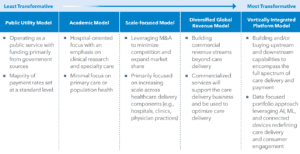Global & Local Forces Defining the World in Which We Live


As provider health systems look toward the next decade, much of the trajectory of healthcare will be defined by broader global forces that will shape the way we work and live. These global forces, either independently or collectively, will influence healthcare and the next decade of innovation that will shape the industry. Some of these forces include:
- Climate Change: The health costs of air pollution and climate change already exceed $800B per year.
- Demographic Changes: 12% of the global population will be over the age of 65 in 2030, up from 8% in 2019. In the U.S., 1-in-5 residents will be of retirement age.
- Rising Inequality: In the US, there is a 12-year difference in life expectancy between those in the top 5% and bottom 5% of household income.
Driven by global forces, the more localized healthcare trends will transform the industry over the next decade and require a reshaping of the LHS business model. These include workforce transformation, consolidation, digitization, and consumer expectations, among others.
All of these global and local influences will collectively play a role in defining the sustainability and relevance of LHS in the coming decade – how LHS respond to these changes will dictate their long-term success by 2030 and beyond.
Archetypes of the Future Leading Health System


Due to these global and healthcare trends, LHS executives expect healthcare to look markedly different by 2030 and are redesigning their organizations to align with this vision of the future.
LHS will move toward new business models that account for the growing risk and capitalize on the opportunities of the shifting market. The next decade will give rise to new archetypes of LHS, and each organization will have to determine which model(s) work best for their system and communities.
As LHS undertake strategic planning for the next decade, leaders must ask themselves three key questions:
- How will global and healthcare trends impact my organization? How will we redesign in response?
- How do we currently define our core business? Is that the right definition for the next decade?
- For the next decade, what is at the center of our flywheel? How do we organize around that?
